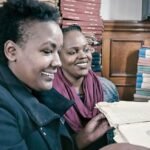24 DAILY NEWS – The Sundance Film Festival witnessed a groundbreaking moment as two documentaries by East African filmmakers premiered in the World Cinema Documentary competition, marking a historic achievement for the region’s film industry, as reported by 24 DAILY NEWS.
PARK CITY, UTAH — For the first time in the Sundance Film Festival’s World Cinema Documentary competition, two films about East Africa — made by East African filmmakers — premiered to global audiences, marking a historic milestone for the region’s creative industry.
From January 23 to February 2, How to Build a Library (Kenya) and Khartoum (Sudan) showcased stories told by African filmmakers themselves, signaling a decisive shift in who gets to define Africa’s narrative on the world stage.
Breaking a Legacy of Underrepresentation
Unlike West Africa — which benefited from colonial-era French investment in cinema — East Africa inherited little to no filmmaking infrastructure from Britain and Germany. Post-independence, economic priorities sidelined the arts.
The result: global perceptions of East Africa have long been shaped by outsiders, often focusing on crisis and conflict. Research from USC’s Annenberg School shows TV audiences are twice as likely to see negative portrayals of Africa than positive ones, a bias that can cost African economies billions in lost investment.
‘How to Build a Library’: Restoring History, Reclaiming Space
Directed by Maia Lekow and Christopher King, How to Build a Library follows two Kenyan women, Shiro and Wachuku, as they fight to restore Nairobi’s colonial-era McMillan Memorial Library. The building, long neglected by the government, is home to archives of Kenya’s colonial past.
Facing political hurdles, skeptical staff, and the monumental task of raising millions, the women’s mission becomes personal when a key official finds a photograph of his late mother in the library’s archives — a moment that crystallizes the project’s importance.
‘Khartoum’: Beyond the Headlines of Sudan’s Civil War
Sudanese filmmakers Anas Saeed, Rawia Alhag, Ibrahim Snoopy, and Timeea Ahmed, alongside British director Phil Cox, present Khartoum — an intimate portrayal of five Sudanese citizens forced into exile by civil war.
Through reenactments, green-screen dreamscapes, and an ethereal score, the film captures life before and after displacement, offering depth and humanity far beyond typical news coverage. It is both cathartic and transformative, focusing on resilience and love rather than despair.
Funding Without Strings Attached
Both films received support from Nairobi-based Docubox East African Film Fund, known for its “no strings attached” financing. This independence allowed filmmakers to avoid the narrative compromises often imposed by European co-production funding, which can reinforce stereotypes.
By maintaining creative control, these filmmakers challenge what Nigerian author Chimamanda Ngozi Adichie calls “the danger of a single story,” offering audiences narratives rooted in local realities.
Why This Moment Matters
While two films alone cannot reverse decades of reductive storytelling, their Sundance success signals a more equitable era in global cinema — one where African perspectives reach international audiences without being filtered through a Western lens.
In a century where Africa will account for 40% of the world’s population, controlling the narrative is more than cultural pride — it is economic and political necessity. These films show that when Africans tell their own stories, they create cultural medicine capable of reshaping global perceptions.


















